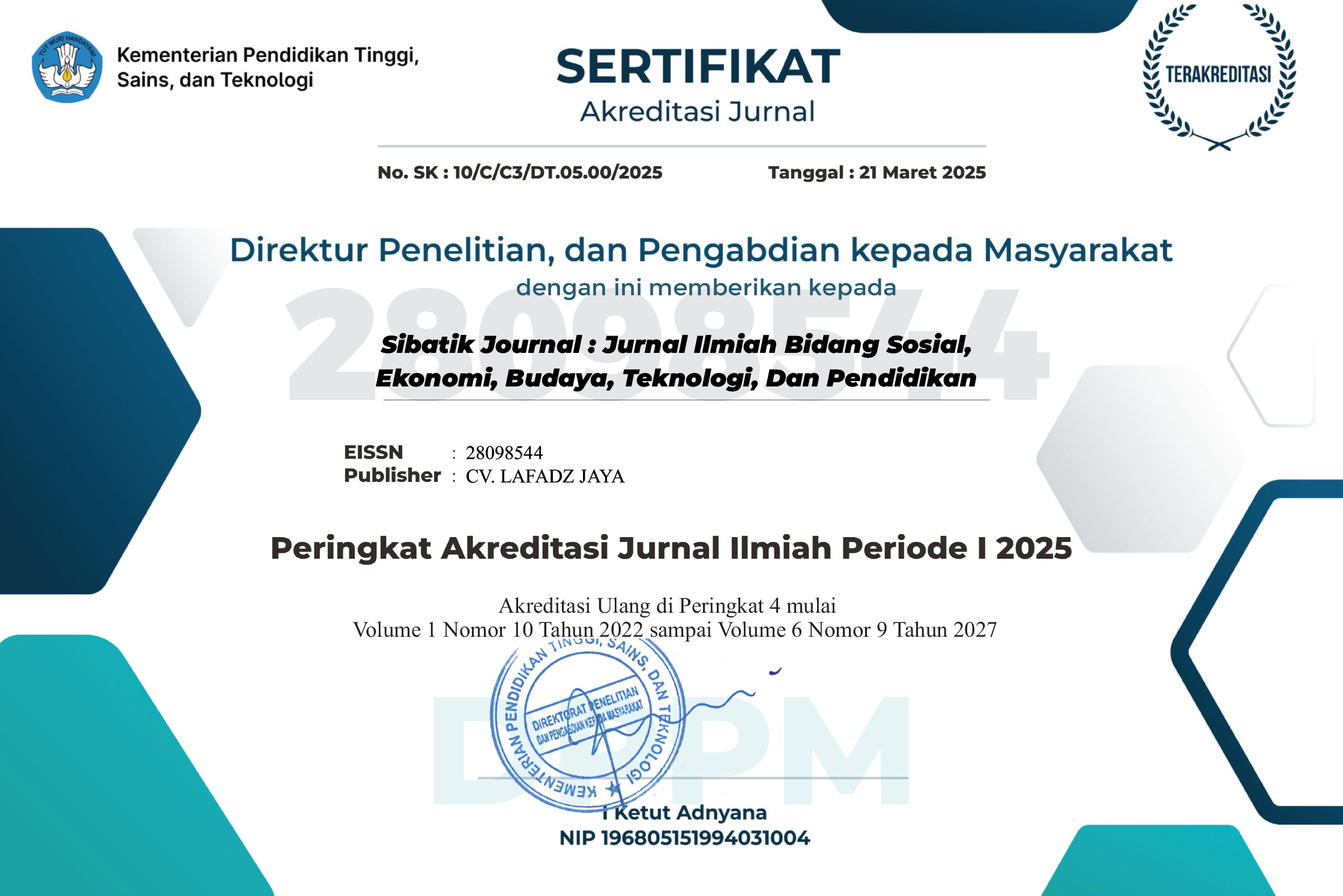MARKETING STRATEGIES IN INCREASING SALES VOLUME OF HOUSING PRODUCTS (STUDY AT PT PILAR KSATRIA TIDAR NUSANTARA KOTA SUKABUMI)
DOI:
10.54443/sibatik.v2i10.1424Published:
2023-09-30Downloads
Abstract
This study aims to determine and explain marketing strategies for increasing the sales volume of housing products of PT Pilar Ksatria Tidar Nusantara Kota Sukabumi related to strategy planning, strategy implementation, and inhibiting factors in implementing marketing strategies. The phenomenon that occurs is a decrease in sales volume caused by the lack of appropriate marketing strategies applied. The data collection techniques are carried out through observation, interviews, documentation, and FGD. The research location is focused on PT Pilar Ksatria Tidar Nusantara Kota Sukabumi. The informants in this study were the President Director, Marketing Director, Managing Director, Finance Director, Logistics Manager, Managing Manager, and supervisory manager of PT Pilar Ksatria Tidar Nusantara Kota Sukabumi as many as 7 people. Data analysis is carried out by selecting answers obtained from informants and then collecting them for analysis and conclusions. The data analysis used is data triangulation. The results showed, that: (1) in making marketing strategy planning has involved expert consultants, but not done with a SWOT analysis approach; (2) in the implementation of marketing strategies have used the 4P approach (Product, Price, Place, and Promotion). By utilizing the advantages of products and prices that are relatively more affordable for the lower middle class. In promotional activities, there are still obstacles in facing competitors who are bolder in promotions and giving discounts. The sales volume in 2021 was 79 housing units, while in 2022 house sales were only 12 housing units or 17.5% of 2021. The contribution of this research is to expand the literature related to marketing management, especially marketing strategies to increase sales.
Keywords:
Marketing Strategy, Sales Volume, Housing ProductsReferences
Alhidayatullah, A., & Antony, A. (2021). Efektivitas dan Efisiensi Modal Kerja Dalam Mempengaruhi Perolehan Return on Asset pada Perusahaan Semen Yang Terdaftar di Bursa Efek Indonesia. Eqien: Jurnal Ekonomi Dan Bisnis, 8(1), 1–12. https://doi.org/10.34308/eqien.v8i1.200
Ammar, O., & Chereau, P. (2018). Business model innovation from the strategic posture perspective: An exploration in manufacturing SMEs. European Business Review, 30(1), 38–65. https://doi.org/10.1108/EBR-09-2016-0119
Arnett, D. B., Wittmann, C. M., & Hansen, J. D. (2021). A process model of tacit knowledge transfer between sales and marketing. Industrial Marketing Management, 93, 259–269. https://doi.org/10.1016/j.indmarman.2021.01.012
Azzadina, I., Huda, A. N., & Sianipar, C. P. M. (2012). Understanding the Relationship between Personality Types, Marketing-mix Factors, and Purchasing Decisions. Procedia - Social and Behavioral Sciences, 65(ICIBSoS), 352–357. https://doi.org/10.1016/j.sbspro.2012.11.133
Blut, M., Teller, C., & Floh, A. (2018). Testing Retail Marketing-Mix Effects on Patronage: A Meta-Analysis. Journal of Retailing, 94(2), 113–135. https://doi.org/10.1016/j.jretai.2018.03.001
Brillinger, A. S., Els, C., Schäfer, B., & Bender, B. (2020). Business model risk and uncertainty factors: Toward building and maintaining profitable and sustainable business models. Business Horizons, 63(1), 121–130. https://doi.org/10.1016/j.bushor.2019.09.009
Cheung, M. L., Pires, G., & Rosenberger, P. J. (2020). The influence of perceived social media marketing elements on consumer–brand engagement and brand knowledge. Asia Pacific Journal of Marketing and Logistics, 32(3), 695–720. https://doi.org/10.1108/APJML-04-2019-0262
Creswell, J. W. (2023). Research Design : Qualitative, Quantitative, and Mixed Methods Approaches (6th ed.). Sage Publications Inc.
Dewsnap, B., Micevski, M., Cadogan, J. W., & Kadic-Maglajlic, S. (2020). Flexibility in marketing & and sales interfacing processes. Industrial Marketing Management, 91, 285–300. https://doi.org/10.1016/j.indmarman.2020.09.005
Friend, S. B., Johnson, J. S., & Ranjan, K. R. (2020). An antecedent and contingent outcome model of fail fast strategy in sales force management. Industrial Marketing Management, 87, 106–116. https://doi.org/10.1016/j.indmarman.2020.02.020
Guenther, M., & Guenther, P. (2020). Is advertising an underappreciated driver of sales growth in B2B markets? Theoretical perspectives and empirical evidence. Industrial Marketing Management, 87, 76–89. https://doi.org/10.1016/j.indmarman.2020.02.019
Haiyan, D., Ahmed, K., & Nanere, M. (2021). LIFE CYCLE, COMPETITIVE STRATEGY, CONTINUOUS INNOVATION and FIRM PERFORMANCE. International Journal of Innovation Management, 25(1). https://doi.org/10.1142/S1363919621500043
Hamad, H., Elbeltagi, I., & El-Gohary, H. (2018). An empirical investigation of business-to-business e-commerce adoption and its impact on SMEs competitive advantage: The case of Egyptian manufacturing SMEs. Strategic Change, 27(3), 209–229. https://doi.org/10.1002/jsc.2196
Heryati, A., & Herdiansyah, M. I. (2020). The Application of Data Mining by Using K Means Clustering Method in Determining New Students’ Admission Promotion Strategy. International Journal of Engineering and Advanced Technology, 9(3), 824–833. https://doi.org/10.35940/ijeat.C5414.029320
Hollebeek, L. D., & Macky, K. (2019). Digital Content Marketing’s Role in Fostering Consumer Engagement, Trust, and Value: Framework, Fundamental Propositions, and Implications. Journal of Interactive Marketing, 45, 27–41. https://doi.org/10.1016/j.intmar.2018.07.003
Hoyle, J. A., Dingus, R., & Wilson, J. H. (2020). An exploration of sales forecasting: sales manager and salesperson perspectives. Journal of Marketing Analytics, 8(3), 127–136. https://doi.org/10.1057/s41270-020-00082-8
Jamil, K., Dunnan, L., Gul, R. F., Shehzad, M. U., Gillani, S. H. M., & Awan, F. H. (2022). Role of Social Media Marketing Activities in Influencing Customer Intentions: A Perspective of a New Emerging Era. Frontiers in Psychology, 12. https://doi.org/10.3389/fpsyg.2021.808525
Johnson, J. S., Matthes, J. M., & Friend, S. B. (2019). Interfacing and customer-facing: Sales and marketing selling centers. Industrial Marketing Management, 77, 41–56. https://doi.org/10.1016/j.indmarman.2017.08.011
Kendall, L. K., & Arellano, F. (2019). Incorporating price elasticity in financial forecasting models: From theory to practice and implementation. Journal of Education for Business, 94(4), 217–227. https://doi.org/10.1080/08832323.2018.1507989
Khudhair, H. Y., Jusoh, A., Mardani, A., & Nor, K. Md. (2019). Quality Seekers As Moderating Effects Between Service Quality and Customer Satisfaction in Airline Industry. International Review of Management and Marketing, 9(4), 74–79. https://doi.org/10.32479/irmm.8144
Kotler and Keller. (2020). Marketing Management (15th ed.). Pearson Education, inc.
Kotler, Hermawan Kartajaya, I. S. (2020). Marketing 4.0. PT Gramedia Pustaka Utama.
Kotler, P. dan A. (2018). Principles of Marketing Seventeenth Edition. Pearson Education Limited.
Li, C. H., Chan, O. L. K., Chow, Y. T., Zhang, X., Tong, P. S., Li, S. P., Ng, H. Y., & Keung, K. L. (2022). Evaluating the Effectiveness of Digital Content Marketing Under Mixed Reality Training Platform on the Online Purchase Intention. Frontiers in Psychology, 13. https://doi.org/10.3389/fpsyg.2022.881019
Londhe, B. R. (2014). Marketing Mix for Next Generation Marketing. Procedia Economics and Finance, 11(1964), 335–340. https://doi.org/10.1016/s2212-5671(14)00201-9
Lu, Q. S., & Miller, R. (2019). How Social Media Communications Combine with Customer Loyalty Management to Boost Green Retail Sales. Journal of Interactive Marketing, 46, 87–100. https://doi.org/10.1016/j.intmar.2018.12.005
Marcos Cuevas, J. (2018). The transformation of professional selling: Implications for leading the modern sales organization. Industrial Marketing Management, 69, 198–208. https://doi.org/10.1016/j.indmarman.2017.12.017
Maricic, B. R., & Dordevic, A. (2014). Strategic Market Segmentation. Marketing, 21(1), 243–251.
Mathew, V., & Soliman, M. (2021). Does digital content marketing affect tourism consumer behavior? An extension of the technology acceptance model. Journal of Consumer Behaviour, 20(1), 61–75. https://doi.org/10.1002/cb.1854
Norsita, D. I., & Hardiyanti, R. (2014). Analysis of Marketing Strategy at Nagoyaramen. In /Agroindustrial Journal (Vol. 3).
Pavlak, M., & Pisar, P. (2020). Strategic management controlling system and its importance for SMEs in the EU. Problems and Perspectives in Management, 18(3), 362–372. https://doi.org/10.21511/ppm.18(3).2020.30
Petrou, A. P., Hadjielias, E., Thanos, I. C., & Dimitratos, P. (2020). Strategic decision-making processes, international environmental munificence, and the accelerated internationalization of SMEs. International Business Review, 29(5). https://doi.org/10.1016/j.ibusrev.2020.101735
Rusmahafi, F. A., & Wulandari, R. (2020). The Effect of Brand Image, Service Quality, and Customer Value on Customer Satisfaction. International Review of Management and Marketing, 10(4), 68–77. https://doi.org/10.32479/irmm.9939
Samanta, I. (2022). Examining relationship marketing and strategic branding in b2b Greek SMEs: A family business development. Innovative Marketing, 18(3), 110–120. https://doi.org/10.21511/im.18(3).2022.10
Shubita, M. F. (2019). Specification of the relationship between the sales expenses and the sales in Jordanian companies. Innovative Marketing, 15(4), 57–65. https://doi.org/10.21511/im.15(4).2019.05
Sugiyono. (2019). Metode Penelitian Kuantitatif, Kualitatif dan R dan D. Alfabeta.
Vadakkepatt, G., Shankar, V., & Varadarajan, R. (2021). Should firms invest more in marketing or R&D to maintain sales leadership? An empirical analysis of sales leader firms. Journal of the Academy of Marketing Science, 49(6), 1088–1108. https://doi.org/10.1007/s11747-021-00774-2
Vlasov, M., Polbitsyn, S. N., Olumekor, M., & Oke, A. (2022). The Influence of Socio-Cultural Factors on Knowledge-Based Innovation and the Digital Economy. Journal of Open Innovation: Technology, Market, and Complexity, 8(4), 1–13. https://doi.org/10.3390/joitmc8040194
Walean, R. H., Harianja, H., & Karwur, E. N. (2020). The Effect of Marketing Mix Towards Consumer Purchase Intention in Carrefour Transmart Kawanua. Klabat Journal of Management, 1(2), 26. http://ejournal.unklab.ac.id/index.php/kjm/article/view/512
Yang, J., Tang, Z., Yuan, Q., & Xu, B. (2021). The economic and social benefits of the government-backed credit guarantee fund under the condition of an economic downturn. Technological Forecasting and Social Change, 166. https://doi.org/10.1016/j.techfore.2021.120632
Yulianthini, N. N., Made, N., Mayasari, D. A., Dewanti, M. A., & Atidira, R. (2021). Customer Orientation and Competitor Orientation Influence on the Marketing Performance of Restaurants MSEs in the Buleleng District.
Zang, Z., Liu, D., Zheng, Y., & Chen, C. (2020). How do the combinations of sales control systems influence sales performance? The mediating roles of distinct customer-oriented behaviors. Industrial Marketing Management, 84, 287–297. https://doi.org/10.1016/j.indmarman.2019.07.015
License
Copyright (c) 2023 Cindy Suherti Suarsa, Erry Sunarya, Darmo H Suwiryo, Munandi Saleh

This work is licensed under a Creative Commons Attribution 4.0 International License.












